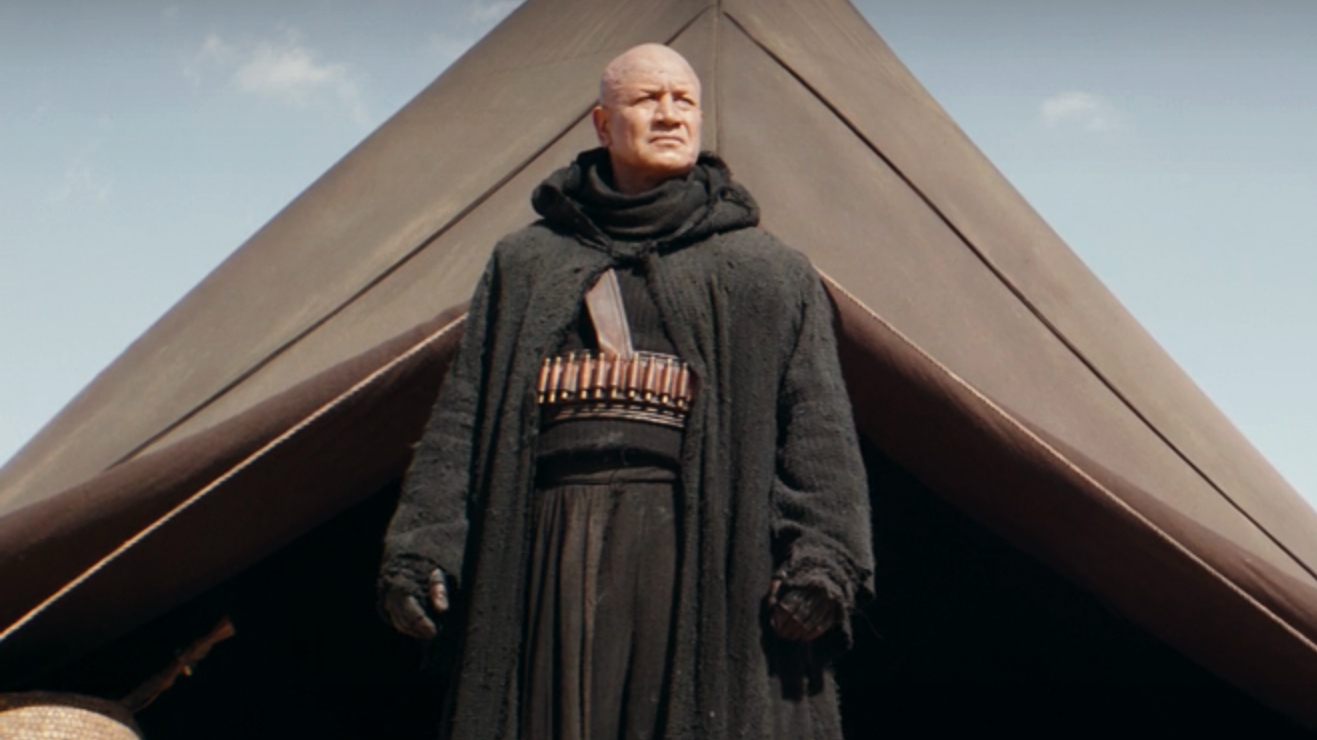Even a story point as dubious as the Rancor gambit at the beginning of the episode can be redeemed. The idea of a hardened assassin being so unnerved by the thought of being eaten that he spills his secrets without even seeing the creature felt cheap. But to have the camera linger for a moment in the beast’s abandoned den to show a lone womprat quietly nibbling away in the corner was disarming enough to dispel my annoyance.
It’s not just the gags, either. The scenes with the robot engineer aboard the spice train were hypnotic. The way it moved its multiple spider limbs across the instruments to reroute power were evocative of Kamajī, the Boiler Man from Spirited Away in the best way. Every Star Wars project post-George Lucas has tried to deconstruct the alchemy of influences and tone that made the original trilogy so unprecedented, and if The Book of Boba Fett has decided it’s going to focus on that feeling of entering the cantina for the first time and seeing a giant, intimidating alien idly rubbing his nose while playing cards? Well, there are worse things.
As for Boba Fett’s burgeoning criminal empire, it’s good that the identity of the mayor wasn’t drawn out as either a big mystery or a secret character reveal. We meet Mok Shaiz almost immediately, and he’s just some Ithorian guy. This prompts a slightly annoying and circuitous sequence of finger pointing as Shaiz deflects responsibility for the assassins, instead pointing Fett to the Sanctuary, where Garsa Fwip sends Fett back outside. It seems Jabba had a couple of layabout cousins, who, no longer content to just be literal debaucherous layabouts, have decided to lay claim to the outer ring syndicate.
Again, this shows a stunning lack of storytelling ambition. It’s the second Death Star in semi-ambulatory slug form. But the visuals of two Hutt siblings entwined on a palanquin together, one hiding demurely behind a too-small fan and the other mopping his brow with a rodent like an overheated southern senator is really fun to watch. A show cannot run on two such disparate tracks forever: Clever production design can only sustain a drab story for a finite amount of time, but so far that’s at least two episodes. Oh yeah, the Wookiee bounty hunter the Hutts brought with is cool too.
“The Tribes Of Tatooine” was almost twice the length of last week’s, and the bulk of it is spent with Boba Fett’s Dances With Wolves/Last Samurai/Lawrence Of Arabia narrative. Hell, Fett is even outfitted like a photo negative Peter O’Toole by the end of the episode. Throughout the entire sequence with the Tusken Raiders, I kept on feeling a twinge about how closely this story arc hewed to that tired white savior trope, but this was mostly allayed by the fact that Temuera Morrison is Maori, who knows the ethnicity of the people inside the sand people costumes, and also, they’re all pretend space people.
This story device is also worth it to gain a more shaded picture of what had been formally a one-note antagonist, completely anonymous and interchangeable by design. The chief explains to Fett that other tribes have resorted to violence in response to aggressive outsiders, but the Tusken Raiders, like everybody, are not defined by a single characteristic. Sure, they can and will happily throw down, but it seems there is a whole kaleidoscope of governing philosophies under the twin suns. And it’s understandable that violence would beget violence, as the tribe regularly comes under attack from a passing hover train.
This, too bears similarity to Native American history, where “hunting by rail” was a common for both idle sport and an attempt to deprive the plains Indians of their primary food source. I don’t know enough about either the migratory patterns of a nomadic desert dwellers or the shifting trade routes of drug trains to understand why just moving out of the way isn’t an option, so why not plan a train heist instead? This is the show’s first big set piece, and it was pretty impressive. While the effects weren’t flawless, the whole sequence had a complexity and kineticism that I wasn’t certain the series could pull off. Firstly, Tusken Raiders on speeder bikes are rad. Secondly, train heists are rad. There’s so much interior and exterior space to play around with. Characters can weave inside and out like little mice poking their heads out of a Swiss cheese. After the tribe champion makes her way through the cars like a dervish, Fett is able to bring the whole thing to an inelegant stop.
This is seemingly the first bloom of Fett’s taste for command. As he parleys with the executive of the Pyke syndicate, he seems to relish being in a position of power. And while it’s never stated where the spice is being transported, it’s likely an arm of the now deceased Jabba’s empire. Thwarting this shipment will likely have repercussions for the tribe going forward, and ultimately contribute to the reason Fett stone cold murders Bib Fortuna beyond just a sudden pique. Fett is rewarded for his exceptional service to the tribe with a lizard up the nose and the first head covering this bald, desert-stranded offworlder has had in weeks. The actual vision Fett experiences via psychokinetic reptile is very silly. Some stuff about identity and duality, some stuff about entrapment and escape. Sarlaccs, trees—that sort of thing. But whatever the spiritual significance of the journey may be, it also yields a very literal branch that he gets to turn into his very own Gaffi stick. Should we all be so fortunate to get big ol’ clubs as a reward for our supernatural insight.
Stray Observations
- There’s a whole scene where Boba Fett secures the speeders from a biker gang at the famed power-converter-dispensing Tosche station. A cut scene from A New Hope originally took place at the station, and this episode even recast Laze and Camie Loneozner—two peers of Luke he liked to whine around. I didn’t discuss it in the main review mostly because it’s the kind of easter egg that does nothing for me. It didn’t add anything and was mostly distracting in its winking at the audience. Also, concerning the Nikto biker gang, did they lean too hard into the American biker gang look? Not hard enough? It kinda had a Chewbacca Tarzan yell vibe to me.
- The robes Fett earns are the same ones he has when we’re first reintroduced to the character in The Mandalorian. So whatever happens between now and then, it didn’t merit a change of clothes.
- There are a lot of jokes about Temuera Morrison’s dad bod, especially in comparison to how Boba Fett looked in Return Of The Jedi. Which, sure, they’re different, but the dude is 61 and got into pretty impressive shape for this show.
- In general, I’m enjoying Morrison’s turn as Fett. It’s not a particularly deep role, but he has the bearing to pull it off well, and is capable of giving some dimension to the hard-assed tough guy cipher.
- Would this show be better if it wasn’t about Boba Fett, but instead a completely new character? Maybe Timothy Oliphant’s Cobb Vanth trying to bring law to Mos Espa? I guess that would just be Deadwood. Nothing about the story feels like it has to be Boba Fett’s, but then again, since he isn’t much of a character, there’s also no reason why it shouldn’t be.
- I absolutely love the massiffs—the Tusken Raider lizard dogs.










































